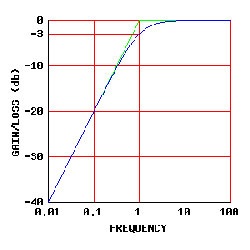If you took a survey of music software apps and hardware, I bet that the majority would have a High-Pass Filter on them.
Regardless of whether its a microphone, microphone preamp, mixer or console, EQ or DAW app, there’s a good chance that a high-pass filter will be incorporated somewhere.
Yet, why is it so overlooked?
The high-pass filter is one of the mixing engineer’s unsung tools. Here’s why:
• The low frequencies of many instruments (especially guitars) just get in the way of each other and don’t add much to the overall sound.
If you roll off the low frequencies below 150 or 200Hz with the high-pass filter on instruments other than the kick and bass, the mix begins to clean up almost magically.
• Rolling off the low frequencies of a vocal mic can eliminate the rumble of trucks and machinery that you can’t hear because they’re so low, yet muddy up the mix.
• Even rolling off the bass and drums at between 40 and 60Hz can sometimes make the mix a lot louder and punchier without affecting the low end much.
The HPF really works like magic to clean up mixes either live or in the studio by rolling off the low frequencies that many times don’t add anything to the sound.
Here’s another EQ tip that also helps to clean things up substantially.
Most engineers these days (especially beginners) tend to put a cardioid mic as close as possible to the instrument or amplifier they’re trying to record. You see this especially on guitar and bass amps where the mic is smashed into the grill cloth.
What happens when you do that is you cause the mic’s low frequency response to increase due to the proximity effect.
The proximity effect only occurs with cardioid or hyper-cardioid microphones, and is a condition where the low frequencies are accentuated (made louder) the closer the mic gets to the source.
The frequency where the proximity effect is centered is different for every mic, but most of low frequencies from the effect can be cleaned up with our friend the high-pass filter.
But while that might take care of the low frequencies pretty well, you still have the 200 to 600Hz region (which is also boosted) to deal with, and the 400 to 600Hz part is a range that most of us don’t find too pleasing to the ear.
What’s more, the more mics that are mashed up against the source, the more those frequencies build up.
So, if during a tracking session you’re using 15 directional mics, boy, is there a lot of build-up in that area.
The way to clean up your tracks (after first using the HPF) is to listen to the song with all the tracks in the mix, and before you EQ anywhere else, attenuate in the 200 to 600Hz area (or even a bit lower, depending upon the mic and the where you set the cutoff frequency of the HPF).
What you’ll find is that suddenly everything will begin to get clearer without having to add any mid or high frequency EQ (which is the first inclination of most engineers).
Of course, the way around the proximity effect in the first place is to mic all your instruments just the way the old timers in the 60’s and 70’s did – from a distance.
It doesn’t have to be much, just a foot or 18 inches will do, but you’ll find that the instruments will begin to blend a lot better and you won’t need nearly as much EQ in the mix.
Bobby Owsinski is an author, producer, music industry veteran and technical consultant who has written numerous books covering all aspects of audio recording. For more information be sure to check out his website and blog.
















